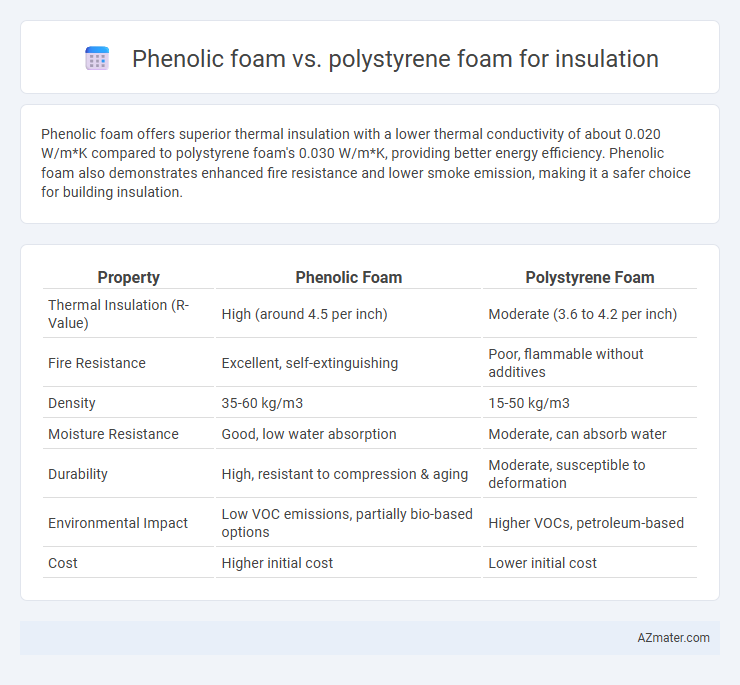Phenolic foam offers superior thermal insulation with a lower thermal conductivity of about 0.020 W/m*K compared to polystyrene foam's 0.030 W/m*K, providing better energy efficiency. Phenolic foam also demonstrates enhanced fire resistance and lower smoke emission, making it a safer choice for building insulation.
Table of Comparison
| Property | Phenolic Foam | Polystyrene Foam |
|---|---|---|
| Thermal Insulation (R-Value) | High (around 4.5 per inch) | Moderate (3.6 to 4.2 per inch) |
| Fire Resistance | Excellent, self-extinguishing | Poor, flammable without additives |
| Density | 35-60 kg/m3 | 15-50 kg/m3 |
| Moisture Resistance | Good, low water absorption | Moderate, can absorb water |
| Durability | High, resistant to compression & aging | Moderate, susceptible to deformation |
| Environmental Impact | Low VOC emissions, partially bio-based options | Higher VOCs, petroleum-based |
| Cost | Higher initial cost | Lower initial cost |
Introduction to Phenolic and Polystyrene Foams
Phenolic foam, known for its superior fire resistance and low smoke emission, offers excellent thermal insulation with a low environmental impact due to its formaldehyde-based resin structure. Polystyrene foam, including expanded (EPS) and extruded (XPS) varieties, provides effective insulation with high moisture resistance and structural rigidity, commonly used in building walls and roofs. Both foams demonstrate distinct advantages in R-value performance and application-specific durability, influencing their selection in construction and industrial insulation projects.
Thermal Insulation Performance Comparison
Phenolic foam offers superior thermal insulation performance compared to polystyrene foam due to its lower thermal conductivity, typically around 0.020 W/m*K versus 0.030-0.040 W/m*K for polystyrene. This lower thermal conductivity results in better energy efficiency and improved temperature regulation in building envelopes. Phenolic foam also exhibits excellent fire resistance properties, enhancing its suitability for high-performance insulation applications.
Fire Resistance: Phenolic vs Polystyrene
Phenolic foam offers superior fire resistance compared to polystyrene foam due to its inherent chemical structure that resists ignition and produces low smoke and toxic gas during combustion. Polystyrene foam is highly flammable, burns rapidly, and releases significant smoke and toxic fumes, making it less suitable for fire-sensitive applications. Building codes increasingly favor phenolic foam for insulation in fire-critical environments, enhancing safety and compliance.
Moisture and Water Vapor Resistance
Phenolic foam offers superior moisture and water vapor resistance compared to polystyrene foam due to its closed-cell structure and low permeability, making it highly effective in preventing moisture ingress and mold growth. Polystyrene foam, particularly expanded polystyrene (EPS), has higher water absorption rates and reduced vapor resistance, which can compromise insulation performance in damp environments. Phenolic foam's robust water vapor barrier properties enhance its suitability for applications requiring long-term thermal efficiency and moisture control.
Compressive Strength and Structural Integrity
Phenolic foam exhibits superior compressive strength compared to polystyrene foam, making it more suitable for applications requiring higher load-bearing capacity. Its closed-cell structure enhances structural integrity by providing greater resistance to deformation under pressure, contributing to long-term durability in insulation systems. Polystyrene foam, while cost-effective, tends to have lower compressive strength and may experience structural weaknesses under heavy loads or prolonged stress.
Environmental Impact and Sustainability
Phenolic foam offers superior thermal insulation with lower environmental impact due to its higher energy efficiency and reduced greenhouse gas emissions compared to polystyrene foam, which relies heavily on petroleum-based resources and emits more volatile organic compounds (VOCs). Polystyrene foam, while cost-effective, poses challenges in biodegradability and recycling, leading to long-term environmental persistence and microplastic pollution. Phenolic foam's enhanced fire resistance and lower smoke production further contribute to safer, more sustainable building insulation solutions.
Installation Methods and Ease of Use
Phenolic foam offers straightforward installation with its lightweight boards that can be easily cut and shaped on-site, reducing labor time and minimizing waste. Polystyrene foam, available in rigid panels and spray forms, requires careful handling due to its brittle nature and sometimes adhesive-based application, which may extend installation time. Both materials provide effective insulation, but phenolic foam's fire-resistant properties and ease of manual manipulation often make it preferable for complex applications requiring precise fitting.
Cost Analysis and Long-Term Value
Phenolic foam typically offers higher upfront costs compared to polystyrene foam but provides superior thermal resistance and fire retardancy, leading to greater energy savings over time. Polystyrene foam, while more affordable initially, may incur higher maintenance and replacement expenses due to lower durability and insulation efficiency. Evaluating long-term value, phenolic foam often proves cost-effective through reduced energy bills and extended lifespan, despite its premium price point.
Health and Safety Considerations
Phenolic foam demonstrates superior fire resistance with low smoke emission and minimal toxic gas release compared to polystyrene foam, reducing health risks during combustion. Polystyrene foam, while effective for insulation, can emit harmful styrene vapors and pose greater hazards in fire situations due to higher flammability and toxic smoke production. Choosing phenolic foam enhances occupant safety by limiting exposure to hazardous chemicals and improving fire resilience in building insulation.
Applications and Suitability for Different Projects
Phenolic foam offers superior fire resistance and low smoke emission, making it ideal for commercial buildings and high-rise constructions where safety regulations are stringent. Polystyrene foam, including expanded (EPS) and extruded (XPS) types, excels in moisture resistance and cost-effectiveness, commonly used in residential insulation, below-grade applications, and roofing systems. Project suitability depends on specific insulation needs, with phenolic foam preferred for critical environments demanding higher fire performance, while polystyrene foam suits budget-sensitive projects requiring durable thermal insulation.

Infographic: Phenolic foam vs Polystyrene foam for Insulation
 azmater.com
azmater.com